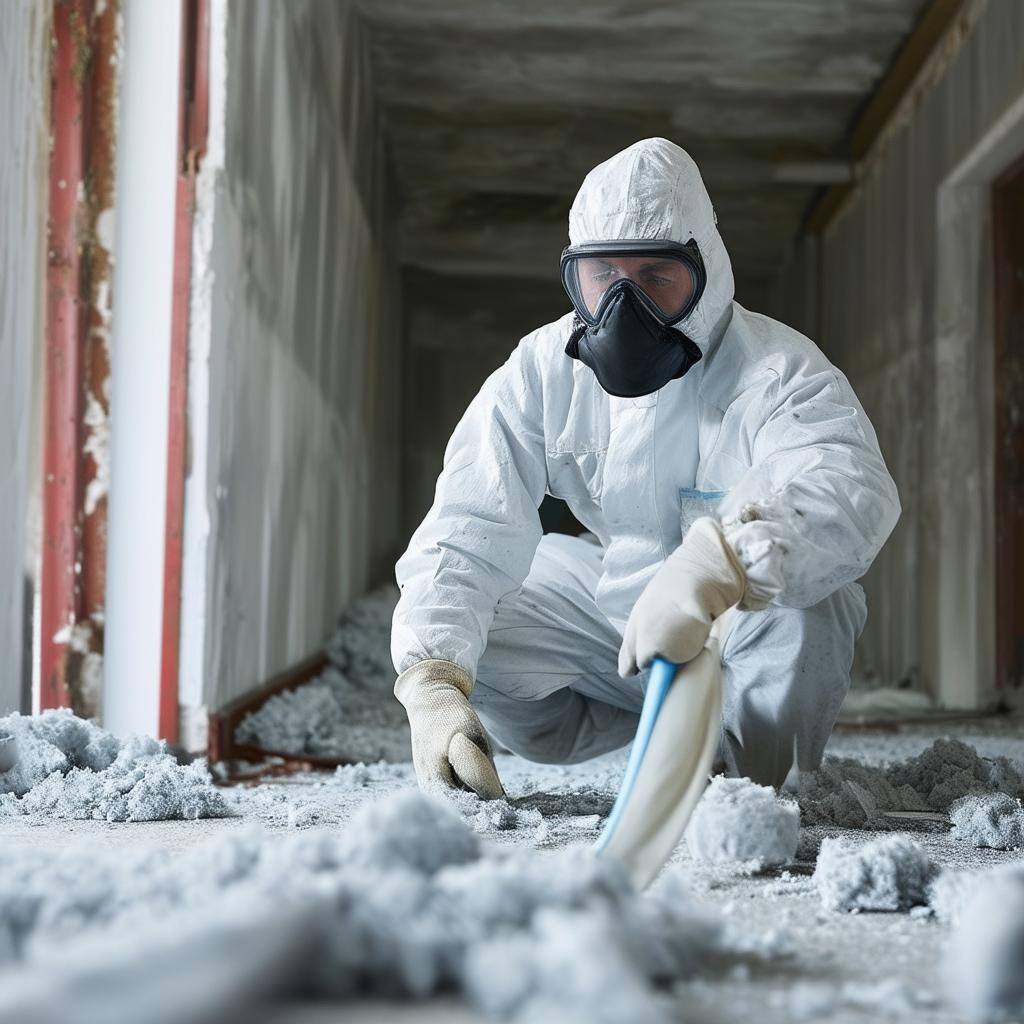Understanding the EPA asbestos abatement notification form - download here!
Understanding the EPA asbestos abatement notification form for key industries
The EPA asbestos abatement notification form is essential for ensuring safety and compliance across industries like property management, construction, and real estate. Whether you're dealing with renovation or demolition, understanding the form is critical to preventing health hazards. Below, we'll break down the different sections of the form, explaining their significance for restoration companies, property managers, general contractors, insurance firms, and real estate professionals. This guide will ensure compliance with asbestos regulations while keeping your team and clients safe. Click here to downlad your form.
What is the EPA Asbestos Abatement Notification Form?
The EPA asbestos abatement notification form is a legal requirement in the U.S. for notifying the EPA when asbestos-containing materials will be disturbed during construction, renovation, or demolition. Failure to comply with this regulation can lead to hefty fines and increased health risks. The form ensures that asbestos is handled safely, keeping your projects compliant with federal laws.
This post provides a detailed guide on how to fill out each section of the form and explains the relevance to your specific industry.
1. Asbestos Compliance for Property Managers
Property managers often deal with older buildings that may contain asbestos. This material poses significant health risks if disturbed, so following the EPA abatement guidelines is essential.
Facility Description: The form requires details such as the building's size, age, and prior use. This section helps property managers assess asbestos risk based on the structure’s history. Filling out this section accurately ensures that asbestos abatement procedures align with the building’s condition.
Type of Operation: Specify whether the operation is a demolition or renovation. For property managers, this section is vital because any renovation work could disturb asbestos, necessitating abatement.
Is Asbestos Present?: This critical question ensures that property managers are fully aware of the asbestos present in their buildings. This is especially relevant for older structures.
Property managers need to comply with local and federal regulations, including submitting this form before starting any demolition or renovation. Following these guidelines minimizes legal risks and enhances tenant safety.
2. Construction asbestos safety
General contractors and construction firms are likely to encounter asbestos during building renovations or demolitions. Understanding the form is crucial for ensuring compliance and avoiding job delays.
Procedure for Detecting Asbestos: Contractors must outline the analytical methods used to detect asbestos in building materials. Knowing how to safely identify asbestos ensures that workers and the surrounding community are not exposed to this dangerous substance. This section also requires contractors to quantify asbestos, ensuring safe removal.
Scheduled Dates for Asbestos Removal: Construction teams must specify the dates when asbestos removal will occur. Planning the abatement process minimizes downtime and ensures the project stays on schedule. Accurate scheduling also allows workers to be prepared with the right safety gear and procedures.
Work Practices and Engineering Controls: Contractors should detail the techniques they will use to safely remove asbestos, including containment methods and air monitoring. By outlining these steps, contractors can demonstrate their commitment to worker safety and regulatory compliance.

3. Is it Legal to Work Around Asbestos?
Many professionals wonder whether they can legally work around asbestos without abatement. The answer is no—unless asbestos is removed or encapsulated, it's illegal to disturb it.
OSHA Regulations: OSHA mandates strict guidelines for working around asbestos. These regulations are designed to protect workers from inhaling asbestos fibers, which can cause serious illnesses like asbestosis and lung cancer. The EPA asbestos notification form plays a key role in ensuring compliance with OSHA guidelines.
By filling out the form and adhering to the listed procedures, your team is protected from legal repercussions, and the worksite remains safe. If asbestos is present, it's essential to halt any work until proper abatement has been conducted.
4. What are the OSHA Regulations for Asbestos in 1971?
OSHA introduced its first asbestos regulations in 1971 to address the rising health concerns associated with asbestos exposure. These regulations set permissible exposure limits (PELs) for workers and mandated protective equipment. Over the years, these guidelines have been refined to better protect workers.
History of Regulations: OSHA's original 1971 asbestos regulations were the first of their kind, setting a precedent for workplace safety. Over time, these rules have evolved to include more stringent controls on asbestos exposure, but they still serve as the foundation for today’s asbestos safety laws.
Application to Modern-Day Projects: Understanding OSHA’s historical regulations helps construction firms and property managers appreciate the long-standing importance of asbestos safety. The EPA asbestos abatement notification form is a key tool for ensuring that today's projects meet these time-tested safety standards.

How to fill out the EPA Asbestos Abatement Notification Form
Filling out this form correctly is critical to maintaining compliance and keeping your team safe. Here’s a breakdown of the main sections:
I. Type of Notification: Indicate whether it’s an original, revised, or canceled notice.
II. Facility Description: Provide details about the building, including its size, age, and use. This section helps the EPA assess asbestos risk.
III. Type of Operation: Specify whether it's a demolition or renovation. Each type requires different levels of asbestos abatement.
IV. Is Asbestos Present?: This section is straightforward but crucial. Make sure to have a thorough inspection to answer this question accurately.
V. Facility Information: Input the details of the building owner and contractor. This is essential for accountability.
VI. Asbestos Detection Procedures: Detail the methods used to detect asbestos. This section helps the EPA ensure that proper protocols are followed.
VII. Amount of Asbestos: Specify the amount of asbestos in the facility. This determines the level of abatement required.
VIII. Demolition/Renovation Schedule: List the project start and end dates to inform the EPA when abatement will occur.
IX. Asbestos Removal Schedule: Provide the start and end dates for asbestos removal.
X. Demolition/Renovation Methods: Outline the methods for safely conducting the project without releasing asbestos fibers into the air.
XI. Waste Disposal: Ensure that asbestos waste is transported and disposed of correctly. This section is key to environmental compliance.

FAQ
1. Why is the EPA asbestos abatement notification form necessary for my industry?
The form is a legal requirement that helps ensure the safe handling of asbestos during renovation or demolition projects. For industries like property management, construction, and real estate, asbestos abatement ensures compliance with federal laws, avoiding hefty fines and protecting workers and occupants from asbestos exposure.
2. How does the EPA asbestos abatement notification form apply to property management and real estate?
Property managers and real estate professionals must ensure that any renovation or demolition involving asbestos-containing materials is reported to the EPA. This form ensures that asbestos is handled safely and in compliance with EPA regulations, protecting tenants, contractors, and the building’s value.
3. What are the key asbestos safety requirements for construction companies?
Construction companies must follow strict procedures outlined in the EPA asbestos abatement notification form, such as identifying asbestos, scheduling abatement, and ensuring proper disposal. Failing to follow these steps can result in legal repercussions and health risks for workers exposed to asbestos fibers.
The EPA asbestos abatement notification form is essential for any industry handling asbestos-containing materials. From property managers to construction firms, this form helps ensure that projects comply with federal regulations while keeping everyone safe. Whether you're conducting a large-scale demolition or a small renovation, following the guidelines in the EPA form can save you from legal trouble and protect your team from asbestos exposure.
At JJ&S Asbestos Abatement Services, we specialize in ensuring safe and compliant asbestos removal for restoration, property management, construction, and other industries. Our expert team is fully trained in EPA and OSHA asbestos regulations, so you can trust us to handle every step of the abatement process. Whether you need help with filling out the EPA notification form or managing asbestos removal on-site, we’re here to ensure your project stays on schedule and compliant with the law.
Let JJ&S Asbestos Abatement Services be your trusted partner in asbestos safety! Reach out to us today for expert guidance and seamless project execution.






